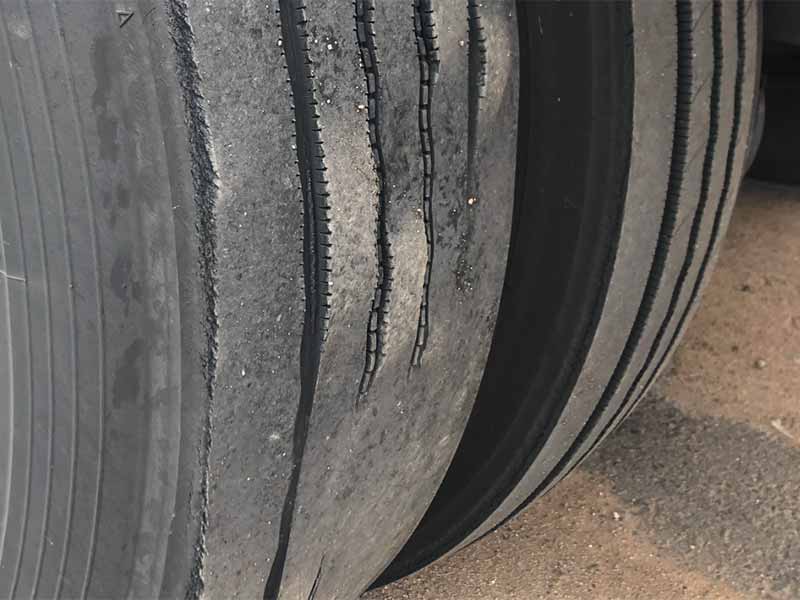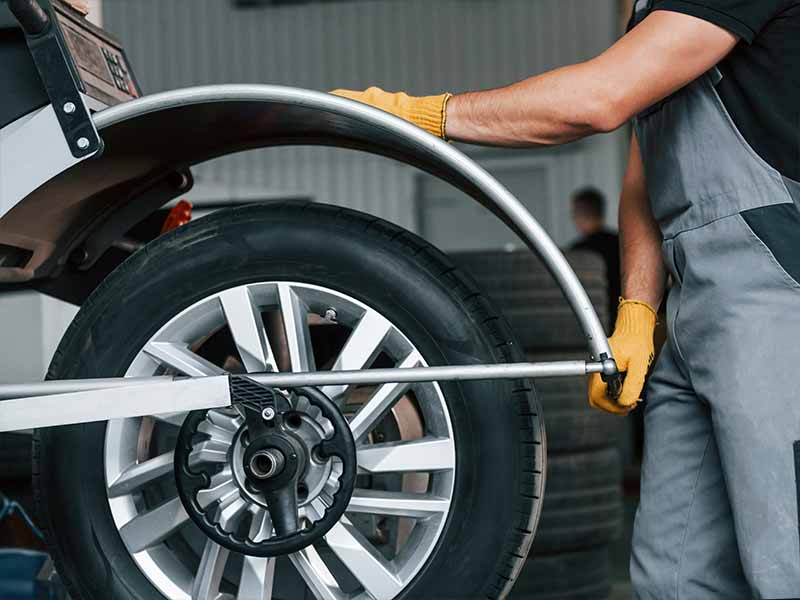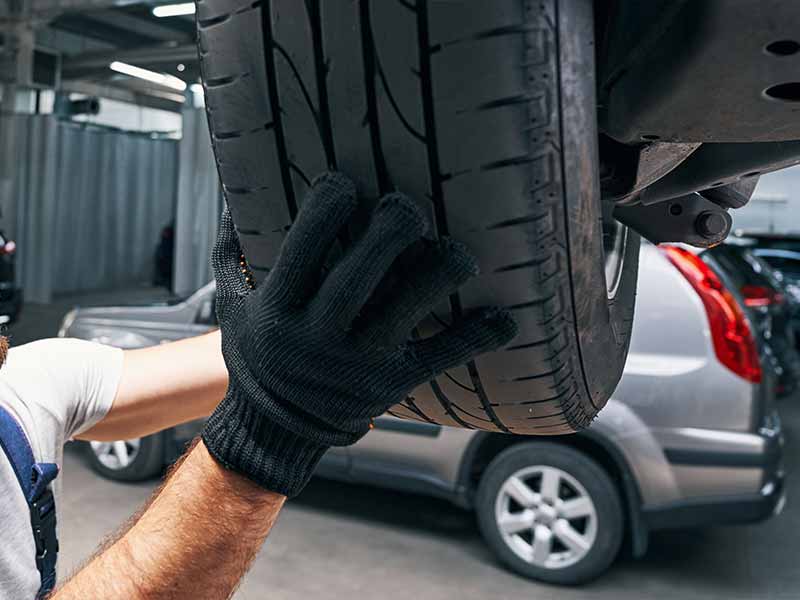Have you ever noticed unusual patterns on your tires or heard strange noises while driving? These could be signs of ‘cupped’ tires, a common but often overlooked problem that could turn your smooth ride into a shaky one.
Will Cupped Tires Smooth Out?
Cupped tires, once they have formed, won’t smooth out on their own without fixing the root cause. However, preventative measures, correct wheel alignment, balancing, tire rotation, and ultimately replacing the affected tires can mitigate the problem.
In this article, we will explore how to identify cupped tires, understand what causes them, and recognize the dangers they pose. We’ll also address whether these tires can be smoothed out and, most importantly, discuss how to prevent tire cupping in the first place.
Let’s take a closer look.
Identifying Cupped Tires
Hey there, road warriors! If you’ve ever wondered how to spot a cupped tire, you’re in the right place. “Cupping” or “scalloping” (fancy words, huh?) are terms we use in the tire world to describe a type of uneven tire wear that looks like little dips or cups in the tire’s tread. But don’t worry, we’ll break it down for you. Let’s dive in!

The Role of Tire Tread
First, let’s talk about the tire tread. This is the part of the tire that makes contact with the road (it’s like the shoe sole of your car). Tire treads have grooves, and their job is to provide traction and whisk away water so you don’t slide around like a duck on a frozen pond. So, if these treads start to look more like a wavy potato chip than a neat pattern, that’s a sign something might be off.
Spotting the Symptoms
Now, onto the symptoms of cupped tires. These are like the sneezes and coughs that tell you a cold might be coming on. For tires, the symptoms include:
- Tire Noise: One of the first things you might notice is your tires sounding louder than usual. You might hear a humming or a rumbling sound that gets louder as you drive faster. It’s like your tires are trying to start their own rock band!
- Uneven Tire Wear: If you look at your tires and see dips or cups in the tread pattern, that’s not good. Your tires should have a nice, even wear. If they look like they’ve been chewed on, it’s probably time for a check-up.
Looking at the Inside Edge
And don’t forget to check the inside edge of your tires, too. If you see wear or cupping on this edge, it’s like finding a hidden clue that your tires are crying out for help.

Causes of Cupped Tires
Alrighty then, let’s get into the nitty-gritty of what causes cupped tires. It’s like solving a mystery, where the clues are your tire’s tread, noise, and wear patterns. Let’s break it down and see what might be causing these strange signs.
The Role of Poor Quality and Worn Tires
Starting with a no-brainer, poor quality and worn tires are more likely to get cupped. It’s like using a cheap pair of sneakers for a marathon. They’ll wear out faster and unevenly. The same thing happens with cheap tires, or tires that are just old and tired (pun intended!).
The Misaligned Tires Factor
Next up is misaligned tires. Imagine you’re pushing a shopping cart, but the wheels are pointing in different directions. Hard to control, right? Well, that’s what happens when your car’s wheel alignment is off. Your tires don’t hit the road evenly, which can lead to uneven tire wear and, you guessed it, cupping!
Unbalanced Tires: A Balancing Act
You might have heard about getting your tires balanced. This is kind of like a circus performer spinning plates. If the weight isn’t evenly distributed, things get wobbly. Unbalanced tires can wear unevenly and start to cup.
Worn Suspension: The Hidden Culprit
Here’s a sneaky one: worn suspension. The suspension is like your car’s cushion, absorbing the bumps from the road. If it’s worn out, your tires can bounce up and down more, hitting the road unevenly and causing — yup, you’ve got it — cupping!
The Front Tires Predicament
Last but not least, let’s talk about those front tires. They do a lot of work, from steering to taking the brunt of braking. This extra load can lead to what we call ‘cupping,’ especially if any of the issues we just talked about are also happening.
Is Cupped Tires Dangerous?
Hey there, folks! So we’ve covered how to identify cupped tires and what causes them. Now let’s tackle a serious question – are cupped tires dangerous? Like riding a rollercoaster with no seatbelt kind of dangerous? Let’s dive into it.
The Risk of High-Speed Driving
Let’s start with highway speeds. When you’re zipping down the freeway, your tires need to be in top shape. But if they’re cupped, it can cause your car to vibrate or shake, which isn’t a fun ride. Plus, it can make it harder for you to control your vehicle, especially if you need to brake suddenly or dodge an obstacle.
Steering Wheel Control: In the Driver’s Seat
Speaking of control, let’s talk about that steering wheel in your hands. With cupped tires, steering can feel shaky or jittery. It’s like trying to play a video game with a glitchy controller – frustrating and potentially unsafe.
Rear Tires: Don’t Forget the Backseat
Even if the problem is in the rear tires, don’t think you’re off the hook. Unstable rear tires can also make the vehicle hard to handle, especially in turns or sudden maneuvers. It’s like riding a bike with a wobbly back wheel – tricky and risky.

Can Cupped Tires be Fixed?
Alright, folks, now for the million-dollar question – can cupped tires be smoothed out? Or are they destined for the scrap heap? The answer’s a bit of a mixed bag. Let’s pull back the curtain and see what we’ve got.
The Great Debate: Smoothing Out or Starting Fresh?
First things first, unfortunately, once a tire is cupped, it won’t magically smooth out by itself. It’s like a bad haircut, once the damage is done, you just have to wait it out. But unlike hair, tires don’t grow back. Bummer, I know.
Getting New Tires: A Fresh Start
So, what are your options? Well, the surefire way to get rid of cupping is to replace the affected tires with new ones. Think of it like getting a brand new pair of shoes after the old ones wore out. But, remember, if you don’t fix what caused the cupping in the first place, your new tires could end up cupped too.
Acting As Soon As Possible
Now here’s where acting as soon as possible comes into play. If your tires are just starting to show signs of cupping, getting them balanced or aligned might slow down the process. So, don’t put off getting your tires checked if you suspect something’s up.

Preventing Tire Cupping
Hey there, tire warriors! After identifying, understanding, and acknowledging the dangers of cupped tires, you might be wondering: how can I prevent my tires from cupping in the first place? Well, let’s jump right into it.
Regular Wheel Alignment Checks
First up, wheel alignment. It’s like making sure your shopping cart wheels are all pointing in the same direction so it doesn’t veer off into a pile of canned beans. Regular wheel alignment checks help ensure that your tires hit the road evenly, reducing the risk of cupping.
The Balancing Act: Weight Matters
Next, we have tire balancing. Remember the circus performer spinning plates? Yeah, your tires need to do the same thing. Regular tire balancing makes sure the weight is evenly distributed, which helps prevent those pesky dips and cups from forming.
Out With the Old: Replacing Worn and Cheap Tires
Here’s a simple one: if your tires are old and worn out, or they’re just cheap quality, it might be time to replace them. Driving on worn or low-quality tires is like running in worn-out shoes, it’s bad for your car’s ‘feet.’
Other Prevention Strategies: Your Toolbox
Lastly, here are a few more tools for your tire cupping prevention toolbox:
- Tire Rotation: Rotating your tires means they wear evenly, reducing the chance of cupping. It’s like swapping your shoes from one foot to the other to make sure they wear evenly (though that might look funny).
- Check Your Suspension: Remember how a worn suspension can cause cupping? Make sure to have it checked out regularly to keep your tires happy.
- Maintain Proper Tire Pressure: Under or over-inflated tires can also lead to cupping. It’s like bouncing on a trampoline that’s too tight or too loose – you won’t bounce properly!
Resources
Below are some links you may find helpful when learning about tires
Final Thoughts
We’ve covered identifying cupped tires, understood what causes this bumpy issue, and realized the dangers they pose on the road. Remember, cupped tires can’t smooth out on their own without addressing the root cause and may require replacing.
Most importantly, never forget the power of prevention. Regular wheel alignment, tire balancing, maintaining proper tire pressure, and replacing worn-out tires can help ensure a smooth and safe ride. Consider this knowledge your toolset for preventing tire cupping, ensuring that your journey on the road remains as smooth as possible.
Good luck and happy motoring.




